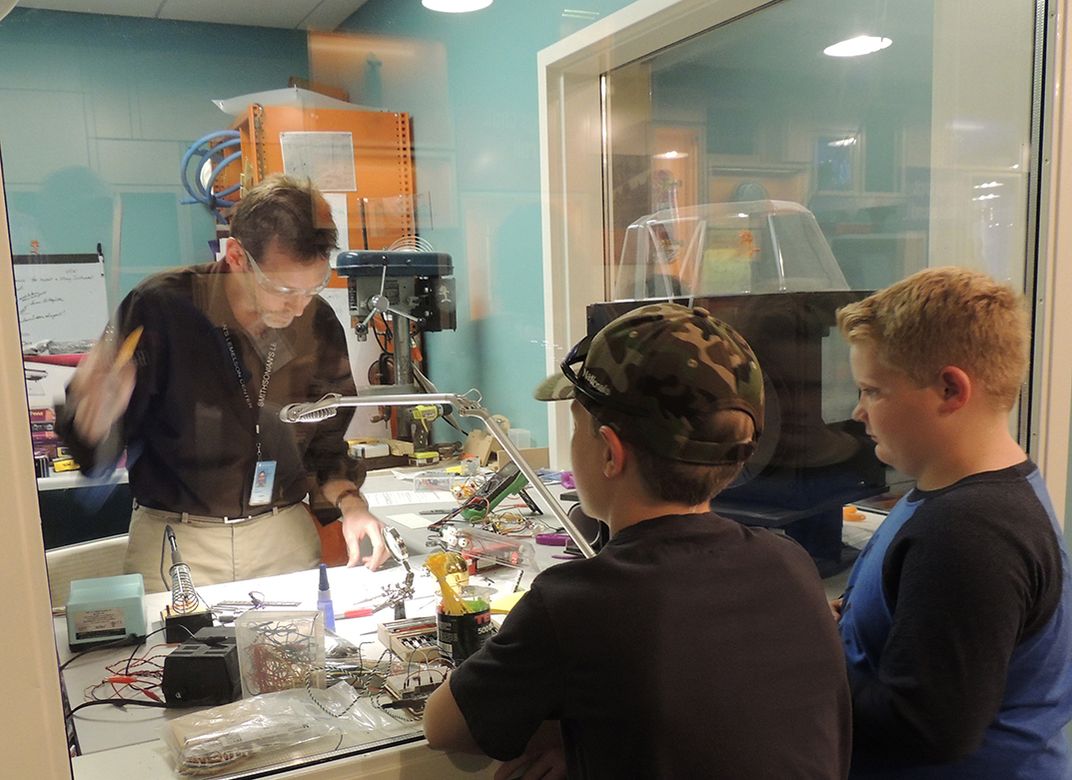Inspiring Invention the MacGyver Way
Visitors to the Smithsonian’s new Spark!Lab are challenged to solve problems with ingenuity and a pile of off-the-shelf items
:focal(633x235:634x236)/https://tf-cmsv2-smithsonianmag-media.s3.amazonaws.com/filer/17/15/1715da66-7a4b-4575-bb37-ae99312751d6/openingweek9web.jpg)
Thirty years ago, the television character Angus MacGyver captured the essence of America’s self-image as a nation of self-reliant defenders of good with a knack for solving an unsolvable problem, using nothing more than a Swiss Army knife and whatever could be found on hand—a paperclip, duct tape and some chewing gum.
The name MacGyver even became a verb, meaning to "jumpstart a car with a cactus," or rather, to solve the problem with grit and good old American ingenuity (and a serious understanding of engineering and physical sciences). Inspiring a generation of tinkerers and professional engineers alike, MacGyver did for engineering what CSI has done for forensic sciences.
Last year, President Obama called for a renewal of that spirit and to become a “nation of makers.” In early July, the National Museum of American History answered the call with the reopening of its hands-on invention space, Spark!Lab in the Lemelson Center for the Study of Invention and Innovation.
The original Spark!Lab—which opened in 2008—was closed in 2012 to allow for museum renovations. “It was one of our most popular things then, and it’s that way again already,” says Tricia Edwards, the center’s director. “We had more than 10,000 visitors in the first week.”
Visitors to Spark!Lab are challenged to solve problems with ingenuity and a pile of off-the-shelf items. Worktables are stocked with tools and straws, dowels, odd shaped pieces of plastic, joiners and connectors, cardboard and tape ready for the taking.
/https://tf-cmsv2-smithsonianmag-media.s3.amazonaws.com/filer/a5/a3/a5a33acf-215f-4b80-9b5e-279e61367e33/openingweek10web.jpg)
What you won’t find are 3D printers, circuit boards, mini-bots or coding technology. Spark!Lab is decidedly low-tech.
“We were interested in re-engaging with real stuff—with hand making,” Edwards says.
Activities are designed with 6 to 12-year olds in mind, and presented as open-ended questions focused on themes that rotate throughout the year. The current theme—“Things that Roll”—includes challenges such as inventing a gyroscope-powered vehicle, a roller coaster or a new kind of skateboard.
Recent visitors have designed such things as a skateboard bus that accommodates multiple riders, and a long board with a windshield to protect the boarder. It’s not about getting it right; it’s about going through the process. Activities for the upcoming themes "Things that Make Sound" and "Things that Help Us See" are in the works.
For inspiration, photographs of real-life inventors and their stories and objects from the museum collection are displayed throughout the 2,000 square-foot space. “We wanted to show the central role invention plays in American history,” Edwards says.
/https://tf-cmsv2-smithsonianmag-media.s3.amazonaws.com/filer/1f/ef/1fef13aa-5824-48c6-b674-b94d81328e23/openingweek2web.jpg)
Some of the inventions included are Eddie Van Halen’s electric guitar, the C-Sprint leg prosthetic inspired by the shape of a cheetah's hind leg, the magnifying glass, Krispy Kreme dough cutter, clothes pins and a machine for curling an entire head of hair at once.
On a recent visit, this reporter noted a few parents and older kids hanging back, more inclined to read the success stories than to jump in, but many of them were drawn to the back where a real, live inventor tinkers behind soundproof windows.
Tim Pula, who is the center's interpretive exhibit coordinator, invents all of the activities for Spark!Lab while maintaining his on-site workshop, chock full of the tools of invention: a soldering iron, a glue gun, spools of colored wire, X-Acto-knives, yellow sticky notes, safety goggles and rulers. There’s no laptop in sight, but somewhere in all of his stuff, there is sure to be a roll of duct tape and some paperclips.
Spark!Lab opened its new permanent location July 1 at the National Museum of American History in the new Innovation Wing. Other centers can be found in: Reno, Nevada; Kansas City, Missouri; Pittsfield, Massachusetts; San Francisco, California and Anchorage, Alaska.
